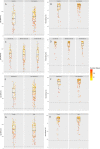Robust Antibody Levels in Both Diabetic and Non-Diabetic Individuals After BNT162b2 mRNA COVID-19 Vaccination
- PMID: 34899701
- PMCID: PMC8652288
- DOI: 10.3389/fimmu.2021.752233
Robust Antibody Levels in Both Diabetic and Non-Diabetic Individuals After BNT162b2 mRNA COVID-19 Vaccination
Abstract
The emergence of effective vaccines for COVID-19 has been welcomed by the world with great optimism. Given their increased susceptibility to COVID-19, the question arises whether individuals with type-2 diabetes mellitus (T2DM) and other metabolic conditions can respond effectively to the mRNA-based vaccine. We aimed to evaluate the levels of anti-SARS-CoV-2 IgG and neutralizing antibodies in people with T2DM and/or other metabolic risk factors (hypertension and obesity) compared to those without. This study included 262 people (81 diabetic and 181 non-diabetic persons) that took two doses of BNT162b2 (Pfizer-BioNTech) mRNA vaccine. Both T2DM and non-diabetic individuals had a robust response to vaccination as demonstrated by their high antibody titers. However, both SARS-CoV-2 IgG and neutralizing antibodies titers were lower in people with T2DM. The mean ( ± 1 standard deviation) levels were 154 ± 49.1 vs. 138 ± 59.4 BAU/ml for IgG and 87.1 ± 11.6 vs. 79.7 ± 19.5% for neutralizing antibodies in individuals without diabetes compared to those with T2DM, respectively. In a multiple linear regression adjusted for individual characteristics, comorbidities, previous COVID-19 infection, and duration since second vaccine dose, diabetics had 13.86 BAU/ml (95% CI: 27.08 to 0.64 BAU/ml, p=0.041) less IgG antibodies and 4.42% (95% CI: 8.53 to 0.32%, p=0.036) fewer neutralizing antibodies than non-diabetics. Hypertension and obesity did not show significant changes in antibody titers. Taken together, both type-2 diabetic and non-diabetic individuals elicited strong immune responses to SARS-CoV-2 BNT162b2 mRNA vaccine; nonetheless, lower levels were seen in people with diabetes. Continuous monitoring of the antibody levels might be a good indicator to guide personalized needs for further booster shots to maintain adaptive immunity. Nonetheless, it is important that people get their COVID-19 vaccination especially people with diabetes.
Keywords: BNT162b2; COVID-19; COVID-19 vaccine; T2D; antibodies; diabetes mellitus type 2; mRNA vaccine; vaccine.
Copyright © 2021 Ali, Alterki, Sindhu, Alahmad, Hammad, Al-Sabah, Alghounaim, Jamal, Aldei, Mairza, Husain, Deverajan, Ahmad, Cherian, Alkhairi, Alkandari, Abubaker, Abu-Farha and Al-Mulla.
Conflict of interest statement
The authors declare that the research was conducted in the absence of any commercial or financial relationships that could be construed as a potential conflict of interest.
Figures


Similar articles
-
BNT162b2 COVID-19 vaccine and correlates of humoral immune responses and dynamics: a prospective, single-centre, longitudinal cohort study in health-care workers.Lancet Respir Med. 2021 Sep;9(9):999-1009. doi: 10.1016/S2213-2600(21)00220-4. Epub 2021 Jul 2. Lancet Respir Med. 2021. PMID: 34224675 Free PMC article.
-
Healthcare Workers in South Korea Maintain a SARS-CoV-2 Antibody Response Six Months After Receiving a Second Dose of the BNT162b2 mRNA Vaccine.Front Immunol. 2022 Jan 31;13:827306. doi: 10.3389/fimmu.2022.827306. eCollection 2022. Front Immunol. 2022. PMID: 35173736 Free PMC article.
-
A single mRNA vaccine dose in COVID-19 patients boosts neutralizing antibodies against SARS-CoV-2 and variants of concern.Cell Rep Med. 2021 Dec 14;3(1):100486. doi: 10.1016/j.xcrm.2021.100486. eCollection 2022 Jan 18. Cell Rep Med. 2021. PMID: 35103254 Free PMC article.
-
Mini Review Immunological Consequences of Immunization With COVID-19 mRNA Vaccines: Preliminary Results.Front Immunol. 2021 Mar 12;12:657711. doi: 10.3389/fimmu.2021.657711. eCollection 2021. Front Immunol. 2021. PMID: 33777055 Free PMC article. Review.
-
Antibody response following SARS-CoV-2 vaccination among patients with type 2 diabetes mellitus: A systematic review.Diabetes Metab Syndr. 2022 Feb;16(2):102406. doi: 10.1016/j.dsx.2022.102406. Epub 2022 Jan 21. Diabetes Metab Syndr. 2022. PMID: 35104750 Free PMC article.
Cited by
-
Reduced antibody response to COVID-19 vaccine composed of inactivated SARS-CoV-2 in diabetic individuals.Front Public Health. 2022 Dec 8;10:1025901. doi: 10.3389/fpubh.2022.1025901. eCollection 2022. Front Public Health. 2022. PMID: 36568756 Free PMC article.
-
Antibody levels in people with diabetes after one dose of the ChAdOx1 nCoV-19 (AZD1222) vaccine.Diabetol Int. 2022 May 5;13(4):637-643. doi: 10.1007/s13340-022-00582-1. eCollection 2022 Oct. Diabetol Int. 2022. PMID: 35528950 Free PMC article.
-
Strategies and safety considerations of booster vaccination in COVID-19.Bosn J Basic Med Sci. 2022 Jun 1;22(3):366-373. doi: 10.17305/bjbms.2021.7082. Bosn J Basic Med Sci. 2022. PMID: 35366790 Free PMC article. Review.
-
COVID-19 Vaccine Effectiveness at a Referral Hospital in Northern Peru: A Retrospective Cohort Study.Vaccines (Basel). 2022 May 20;10(5):812. doi: 10.3390/vaccines10050812. Vaccines (Basel). 2022. PMID: 35632567 Free PMC article.
-
Effect of Comorbid Diabetes on Clinical Characteristics of COVID-19 Patients Infected by the Wild-Type or Delta Variant of SARS-CoV-2.Front Endocrinol (Lausanne). 2022 May 4;13:861443. doi: 10.3389/fendo.2022.861443. eCollection 2022. Front Endocrinol (Lausanne). 2022. PMID: 35600601 Free PMC article.
References
Publication types
MeSH terms
Substances
LinkOut - more resources
Full Text Sources
Medical
Miscellaneous

